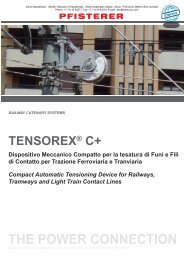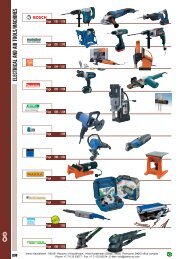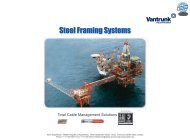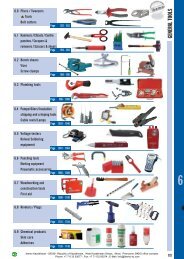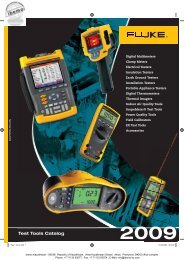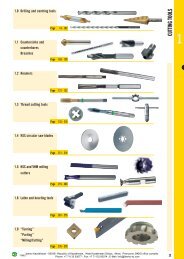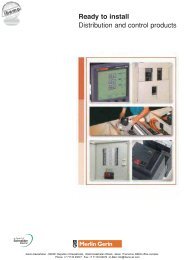General Catalogue 2007 - Ibemo Kazakhstan Ltd
General Catalogue 2007 - Ibemo Kazakhstan Ltd
General Catalogue 2007 - Ibemo Kazakhstan Ltd
Create successful ePaper yourself
Turn your PDF publications into a flip-book with our unique Google optimized e-Paper software.
Fig 14<br />
Time in Seconds<br />
10000<br />
6000<br />
4000<br />
3600<br />
2000<br />
1000<br />
600<br />
400<br />
200<br />
100<br />
60<br />
40<br />
20<br />
10<br />
6<br />
4<br />
2<br />
1<br />
0,6<br />
0,4<br />
0,2<br />
0,1<br />
0,04<br />
0,02<br />
0,01<br />
0,004<br />
1 1,5 2 3 4 6 8 10 15 20 30 40<br />
1,13<br />
1,45<br />
Multiples of In<br />
C<br />
S<br />
M<br />
Feeder<br />
circuit<br />
breaker<br />
Remote<br />
starter<br />
Motor<br />
Direct start<br />
Full load Full load Starting Starting<br />
speed current current torque<br />
kW hp rev/min A x FLC x FLC<br />
2800 3.2 6.75 3<br />
1400 3.5 5.5 2.5<br />
1.5 2 900 3.8 4.5 2.2<br />
700 4.3 4.0 2.0<br />
Table 27<br />
Fig 15<br />
Hager <strong>Catalogue</strong> <strong>2007</strong> • Technical<br />
MCCB Motor Power Circuit Protection<br />
Motor Power Circuit Protection<br />
The selection of the circuit protective device for motor power supply<br />
circuits depends in the first instance on the relative physical position<br />
of the various circuit elements. The feeder circuit breaker in the<br />
switchboard, panelboard or distribution board, the starter with its<br />
contactor and thermal overload relay, with perhaps its own isolator or<br />
short-circuit protective device (SCPD) and of course the motor.<br />
The feeder circuit breaker, which can be a perfectly standard thermal<br />
magnetic breaker, must protect the cable feeding the starter so the<br />
normal selection criteria apply. In addition, however, it must be able<br />
to withstand the inrush and starting currents of the motor without<br />
nuisance tripping. The inrush current, which should not be confused<br />
with the starting current, appears at the instant of switch on and<br />
could be as great as 10 times the full load current (FLC) of the motor,<br />
but with a relatively short pulse time of 20 to 30 milliseconds.<br />
The starting current of a direct on line (DOL) start squirrel cage<br />
motor does vary with the designed speed of the motor - the higher<br />
the speed the higher the starting torque and the starting current as<br />
a ratio of the FLC. However the FLC is inversely proportional to the<br />
design speed of the motor. Table 27 shows typical performance data<br />
for average 1.5kw/2hp three phase squirrel cage motors.<br />
The run-up time can vary between one and fifteen seconds<br />
depending on the surge of the motor and the type of load the motor<br />
is driving.<br />
Clearly then, to accurately select the correct circuit breaker for a<br />
motor power supply circuit it is essential to know the correct FLC, the<br />
starting current and the run-up time. This information is then plotted<br />
against the time/current characteristic curve of the type of circuit<br />
breaker (or fuse) selected.<br />
Example<br />
Select an appropriate feeder circuit breaker to supply a 1.5kw 3<br />
phase motor DOL start. FLC 3.5A, starting current 5.5 x FLC, run-up<br />
time 6 secs. The circuit breaker must be suitable for fitting into a 3<br />
phase MCB Distribution Board.<br />
Starting current: 3.5 x 5.5 = 19.25A for 6 secs<br />
Inrush current : 3.5 x 10 = 35A<br />
Comparing the data against the time/current characteristics of a type<br />
C MCB, Fig 15, we see that at 6 secs the breaker will carry 2 x In<br />
without tripping. Therefore a 10A MCB would carry 20A for 6 secs.<br />
The minimum instantaneous trip for this type C MCB would be 50A.<br />
Therefore the closest protection for this motor feeder circuit would<br />
be a 3 Pole 10A type C MCB. A 10A type D could be used providing<br />
the 100A maximum instantaneous trip was not a problem. The inrush<br />
current would preclude the use of a 10A type B because the<br />
minimum instantaneous trip is only 30A. In this case use the next<br />
size up, i.e. 16A.<br />
ibemo <strong>Kazakhstan</strong> - 090301 Republic of <strong>Kazakhstan</strong>, West <strong>Kazakhstan</strong> Oblast, Aksai, Pramzone, BKKS office complex<br />
Phone: +7 71133 93077 ; Fax: +7 71133 93074 ; E-Mail: info@ibemo-kz.com<br />
3.43<br />
Protection<br />
Devices



